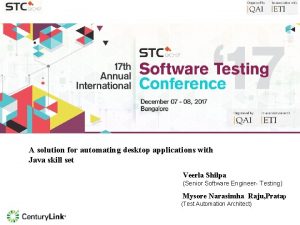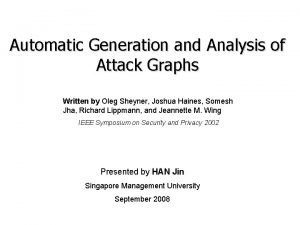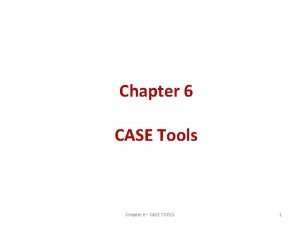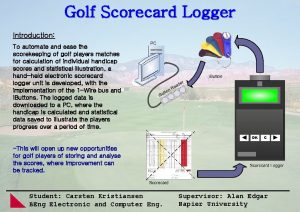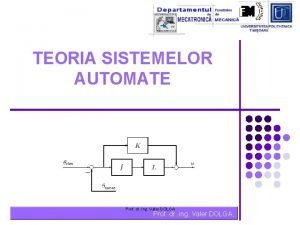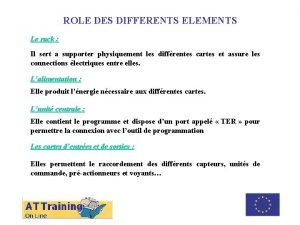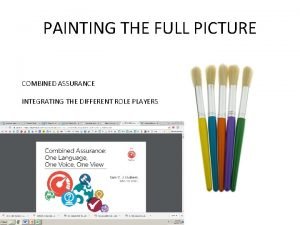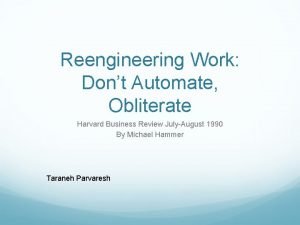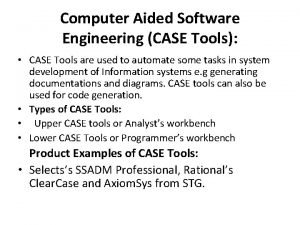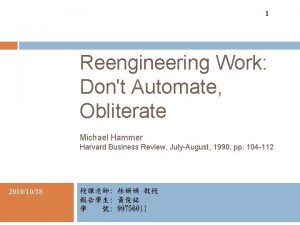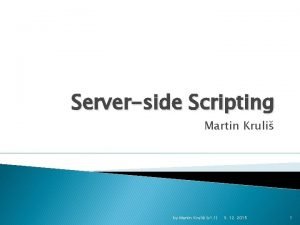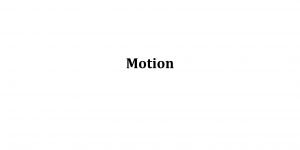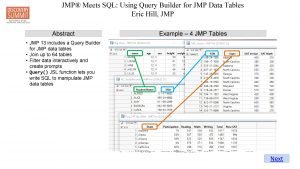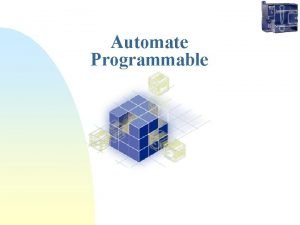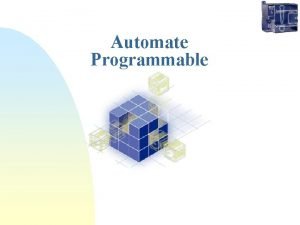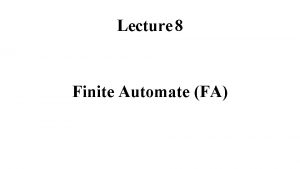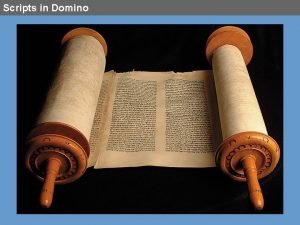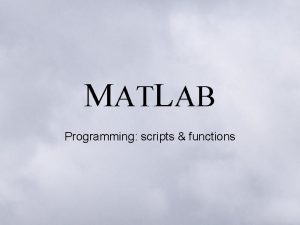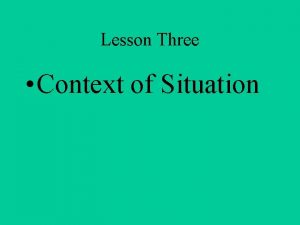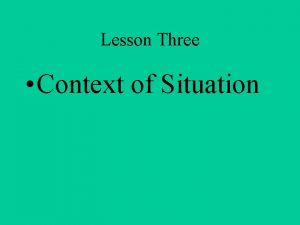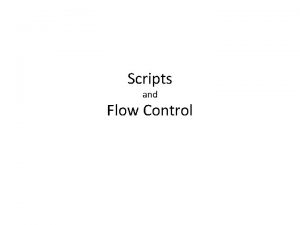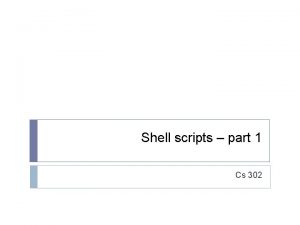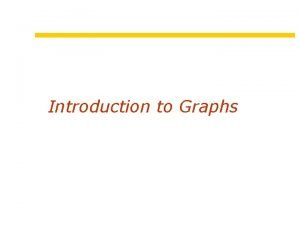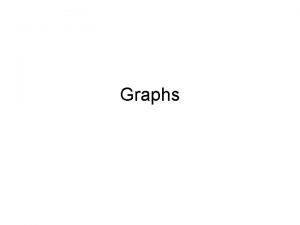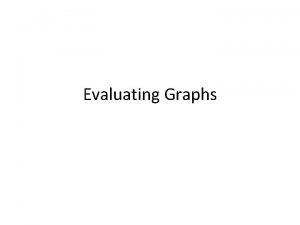Using JMP Scripts to Automate Generation of Graphs
































- Slides: 32

Using JMP® Scripts to Automate Generation of Graphs and Analysis for Bio. Pharmaceutical Manufacturing Studies Jessica A. Behrle, Associate Director Yinglei Li, Senior Statistician Quantitative Sciences, Janssen R&D September 21, 2016 Melinda, Tree of Life Melinda’s artwork reflects her journey living with HIV.

Bio. Pharmaceutical Manufacturing 15, 000 L bioreactor Upstream (grow cells to make product*) Purification columns Downstream (purify the product*) Drug Substance (stored in plastic containers) Vials that Patient Receives *Product used in these studies was a monoclonal antibody. 2

Changes in Process (Locations) Product manufactured at new sites must be comparable to that from approved product site. 3

Other Changes Delivery Method(s) Intravenous (IV) product Injectable product Dose Downstream Processing Changes Purification Columns 100 mg/400 mg vials 4

Why degradation studies? § Regulatory Guidance ICH Q 5 E (www. ich. org) COMPARABILITY OF BIOTECHNOLOGICAL/BIOLOGICAL PRODUCTS SUBJECT TO CHANGES IN THEIR MANUFACTURING PROCESS – Manufacturer must prove that manufacturing process changes will not adversely impact product quality, safety and efficacy: § At release (time 0) § During storage: Stability data, including those generated from accelerated or stress conditions, is used to evaluate any differences in the degradation pathways of the pre-change and post-change product. – Involves significant analytical testing to evaluate different structural features. (Protein structure is frequently sensitive to a variety of process changes. ) 5

ENSURE QUALITY 6

Stress Condition: Heat 5˚C = 41˚F A cold day 25˚C = 77˚F A warm day 40˚C = 104˚F A hot day https: //www. mathsisfun. com/measure/thermometer. html 7

Why do we need a slope comparison? • Comparing the slopes on stability is a Quantitative assessment of the data • Are the pre and post degrading or changing over time at the same rate? • Minimize subjectivity • Assuming linear slopes & normal data • Science plays a role in interpreting the statistical differences. • P-values are a guide but also need to see degradation. 8

Slopes comparison of two regression lines 9

Nice Example! “Highly similar” degradation trends (slopes) 10

Not So Nice Example! • Analytical method variability can contribute to difficulty in evaluating trends. 11

No point and click slope comparison in JMP • Batch. ID *Time does not provide the comparisons between two batches • Multiple Comparisons enables comparisons of intercepts and comparisons at specific timepoints but not comparisons of slopes directly. 12

Degradation Analysis (Reliability and Survival) • Estimate individual slope and intercept • No comparisons of slopes and intercepts 13

Why automate? Purity A (%) Purity K (%) Purity B (%) Impurity C (%) Impurity D (%) Conc E (mg/m. L) Purity L (%) Impurity M (%) Impurity N (%) Conc O (mg/m. L) Conc P (%) Attribute Q Attribute R Attribute S Attribute T Conc F (%) Attribute G Attribute H Attribute I Attribute J 20 x 3 = 60 analyses 14

Even more reasons for Automation • • Scripts to perform the slope comparison for all attributes Generate all the Graphs Consistent study design for these studies Enable scientists to analyze 15

Objective § Graphically and statistically evaluate the trends and differences in the trends between the batches for all storage conditions and attributes § Aim to develop automation tool 16

Example & Demonstration

Example data 18

Transpose the data Subset the data by pairs of pre-changes vs post-change batches 19

Long data 20

Graphs code § Basic graph by attributes for a loop 21

Graphs (continue) Display the plot and define the graph elements Put all plots together in a window 22

Output 23

Summary table of Statistical Results Nested loop by both assays and temperatures 24

Tables (Continue) 25

Statistical Results 26

More code tips from my scripts § Append add a display box for each variable in the analysis to the bottom of an existing display § Send To Report and Dispatch commands are useful to customize the appearance of a plot § Table box is to create a table with Number Col Box for a numerical column and string col box for a string column § New Window command displays all graphs in a window 27

Learning Scripting tips § JMP/SAS blog---provides kinds of search question results § Book: Jump into JMP Scripting; Scripting Guide PDF in JMP § View, edit and experiment with scripts created using JMP Commands § Searching the help Index § Troubleshooting 28

Future Considerations § Statistics Considerations – Analyzing all batches together – Adjusting for Multiplicity – Variability (pooled vs unpooled etc. ) used in evaluating the differences – Equivalency testing – CI on differences – Comparisons of intercepts § Scripting Considerations – User defined attributes/temperatures to analyze – Creating one report file of all graphs and tables (i. e. , easy exportation to word to merge into a report) 29

References § Wendy Murphrey; Rosemary Lucas. Jump Into Jmp Scripting. SAS Institute. ISBN 978 -1 -59994 -658 -0. Retrieved 14 December 2012. § SAS Publishing (1 March 2012). Jmp 10 Scripting Guide. SAS Institute. ISBN 978 -1 -61290 -195 -4. Retrieved 13 December 2012. § J. M. Andrade, M. G. Estévez-Pérez. Statistical comparison of the slopes of two regression lines: a tutorial. Anal Chim Acta, 838 (2014), pp. 1– 12 30

Thank you Barry Hogan, Senior Scientist, Janssen R&D Yonghui Wang, Senior Scientist, Janssen R&D Michael Nedved, Associate Director, Janssen R&D Jessica A. Behrle, jbehrle@its. jnj. com Yinglei Li, yli 268@its. jnj. com September 21, 2016 Melinda, Tree of Life Melinda’s artwork reflects her journey living with HIV.

 How to automate desktop application using java
How to automate desktop application using java Stahl
Stahl You're good and your mercy is forever
You're good and your mercy is forever Automated generation and analysis of attack graphs
Automated generation and analysis of attack graphs Graphs that enlighten and graphs that deceive
Graphs that enlighten and graphs that deceive End behavior of polynomials
End behavior of polynomials Software implementation of state graph
Software implementation of state graph Graphs that compare distance and time are called
Graphs that compare distance and time are called Essa eliminate simplify standardize automate
Essa eliminate simplify standardize automate Langage fbd automate
Langage fbd automate Python desktop automation
Python desktop automation Long tail automate
Long tail automate Logique positive automate
Logique positive automate Case tools automate
Case tools automate Automate scorecard
Automate scorecard Power automate
Power automate Automate asset management
Automate asset management Teoria sistemelor automate
Teoria sistemelor automate Racks pour automate
Racks pour automate Parse xml in power automate
Parse xml in power automate Who invented the first computer
Who invented the first computer Ab python weap ii
Ab python weap ii Combined assurance automation
Combined assurance automation Rla automate sc nice
Rla automate sc nice Michael hammer 1990 harvard business review
Michael hammer 1990 harvard business review Computer aided software engineering tools examples
Computer aided software engineering tools examples Reengineering work: don’t automate, obliterate
Reengineering work: don’t automate, obliterate How to automate repetitive tasks in excel
How to automate repetitive tasks in excel Serverside scripts
Serverside scripts Romeo and juliet oh romeo
Romeo and juliet oh romeo Contoh gerakan blok motion
Contoh gerakan blok motion What is java scripts
What is java scripts Indexoptimize
Indexoptimize
